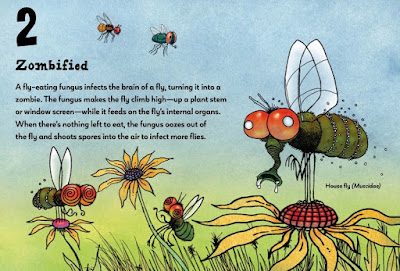Today I (Tina Cho) welcome my writing friend and one of my critique partners--Carrie Finison! Her latest picture book, Don't Hug Doug, hit bookstores the end of January. Carrie is sharing some expert advice on writing in second person point of view and benefits of doing so. Take it away, Carrie!
One
day, when Doug was hammering and gluing and generally minding his own business,
some relatives stopped by. They’d been invited to lunch.
Aunt
Muriel wrapped him in a pillowy, billowy embrace. “Such twirly curls! And such
big, brown, puppy dog eyes!”
“He’s
squishier than a jelly doughnut,” said Uncle Hank-the-Tank.
“Dug-ga-hug-ga,”
babbled sticky Sukey.
They
hugged him and squeezed him and squooshed him and smooshed him.
Their
hugs made Doug feel as shriveled and wrung out as a week-old balloon. But he
thought it would be rude to say so.
He
tried going stiff, but they just hugged him tighter. He tried going limp, but
they just hugged him longer…and longer…and LONGER.
I liked the story told this way, but I could not get the
ending right. In one version, Doug built a robot for his relatives to hug
instead of him. In another version, he adopted a puppy to soak up their
attention. In another version, he set up a booby trap with a giant stuffed
animal who took on their enthusiastic embraces.
While these endings were fun, and funny, they felt wrong
because they didn’t truly solve Doug’s problem. Yes, he managed to avoid his
relatives’ hugs — this time. But what about next time? Or the time after that?
Eventually, he’d be right back where he started. His real problem wasn’t
avoiding a single hug — it was getting his relatives to listen to him and
accept the fact that he didn’t want hugs from them.
THAT problem felt insurmountable. How could Doug solve this
problem? How could ANY kid solve it? The truth is, adults often don’t listen to
children’s wishes when it comes to hugging (and lots of other things, too) —
and often they don’t even think to ask in the first place.
Doug, I realized, could not force his relatives to listen to
him — but I could. As the writer, I could make readers say things out loud. I
could make them say things to each other. I could give them an invitation to
interact — with the book, and with each other.
I rewrote the story in the second person point of view,
addressing the reader. Here it is in published form:
 |
The beauty of
writing from the second person is that you create an interactive experience. In
this case, I wanted both child and adult readers to have plenty of practice
asking and answering the question, “Do you want a hug?” So I made them say it
out loud, right in the text of the book. (Cue writerly cackle.)
And, I could
give them a chance to physically practice a high five as an alterative to
hugging.
Thinking more
broadly, the second person point of view can be helpful in an array of
circumstances:
-
You
want your reader’s experience to be interactive — either verbally (the reader
says things out loud) or physically (the reader physically interacts with the
book in some way).
-
You
want to immerse your reader in the experience of the main character. In these
books, the narrator addresses the main character of the book as ‘you’ and the
reader “becomes” the main character.
-
You
want to persuade the reader.
-
You
want to convey a familiar childhood experience in a humorous way.
Don’t Feed the Coos by Jonathan Stutzman, illustrated by Heather Fox
Don’t Push the Button by Bill Cotter
The Elephant’s Guide to Hide and Seek by Kjersten Hays, illustrated by Gladys Jose
Flying Deep: Climb Inside Deep-Sea Submersible Alvin by Michelle Cusolito, illustrated by Nicole Wong
How Do You Dance? by Thyra Heder
How to Babysit a Grandpa by Jean Reagan, illustrated by Lee Wildish
How to Wear a Sari by Darshana Khiani, illustrated by Joanne Lew-Vriethoff
If You Decide to Go to the Moon by Faith McNulty, illustrated by Steve Kellogg
If Your Monster Won’t Go to Bed by Denise Vega, illustrated by Zachariah O’Hora
The Iridescence of Birds: A Book About Henri Matisse by Patricia MacLachlan, illustrated by Hadley Hooper
The Secret Code Inside You by Rajani LaRocca, illustrated by Steven Salerno
Warning: Do Not Open This Book! by Adam Lehrhaupt, illustrated by Matthew Forsythe
When Grandma Gives You a Lemon Tree by Jamie L.B. Deenihan, illustrated by Lorraine Rocha
When Your Elephant Has the Sniffles by Susanna Leonard Hill, illustrated by Daniel Wiseman
You DON’T Want a Unicorn by Ame Dyckman, illustrated by Liz Climo






























